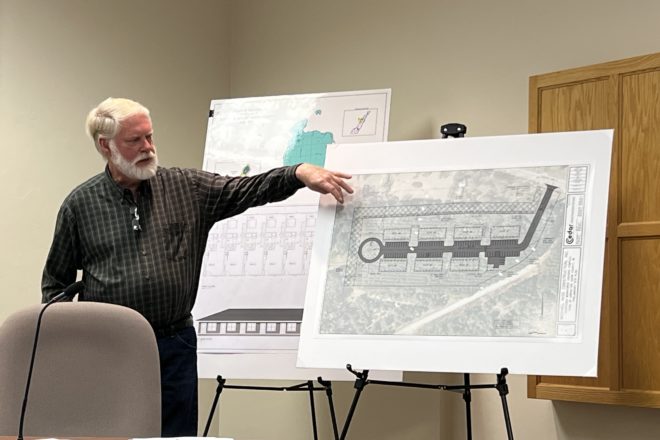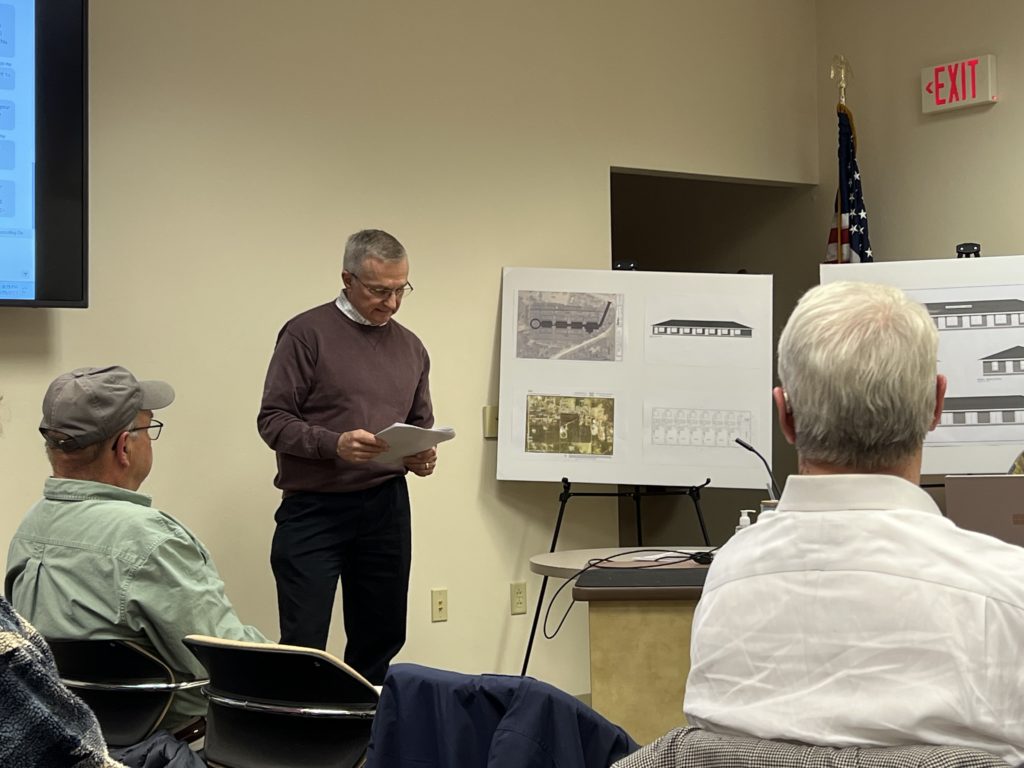Rezoning Recommended for Fish Creek Workforce Housing
- Share
- Tweet
- Pin
- Share

The Gibraltar Plan Commission is recommending that the Gibraltar Town Board support a petition to rezone 4.90 acres at 3815 Cty F from Light Industrial (LI) to Neighborhood Residential (NR).
The commission’s 3-2 decision to support the zoning change – chair Linda Merline and alternate board member Wayne Kudick did not support the recommendation – came during an April 25 meeting after a 30-minute presentation by Michael Niss, the project’s developer, and about an hour and a half of public discussion on the subject.
Niss, on behalf of the Fish Creek Sanitary District, is seeking this zoning change so that he can apply for a conditional-use permit to establish a 49-unit apartment complex in that area. The Town of Gibraltar has county zoning, so the County of Door would make the decision about the rezoning request and the conditional-use permits to follow, with the town only making a recommendation for or against a request.
About 35 people attended the meeting in person, and about 10 more participated online.
The majority expressed disapproval for the project. One of the most commonly cited concerns was the project’s proposed location: The apartments would be located in a human-made pine forest designed to serve as a buffer between the sanitary treatment plant and nearby houses.
Of the participants who spoke in favor of the project, many cited struggles to find housing for themselves and their employees. Others pointed out that the plan commission’s stamp of approval would be a step toward ascertaining whether the project would be suitable for the area.
How the Proposed Project Came Together
Niss, a Baileys Harbor resident and the owner of Michael Niss Construction, had experienced housing-related problems for years. Working in construction, he had struggled to find contractors for electrical, plumbing, painting and heating work; he had heard stories about experienced workers who were forced to decline local job offers due to a lack of housing; and he saw workers who were near the ends of their careers with no one to replace them.
But in Niss’s view, little had been done to fix the issue. That’s why, around the fall of 2022, he approached several Fish Creek businesses with his idea for a workforce apartment complex. Each business he talked with echoed a need for housing.
So Niss took his idea to Gibraltar chair Steve Sohns and town administrator Travis Thyssen, who had been tasked with looking for ways to address the housing crisis when he was hired as the town’s first administrator in 2021. Because of that, Thyssen had already been on the lookout for potential housing locations.
An ideal site for a housing project would be on a sewer line already, Niss said, because if it wasn’t, getting sewer access would be costly. Niss also wanted the buildings to be close enough to the downtown area to make for a bikeable or walkable commute.
The lot located on County F, east of Little Spring Road, met both of those criteria. Plus, it is owned by the Fish Creek Sanitary District and is “not prime real estate” due to its proximity to Fish Creek’s sanitation plant, making it relatively inexpensive.
“This is one of those once-in-a-lifetime opportunities,” Thyssen said of the location they found.
Whether Niss would buy or lease the land from the sanitary district hasn’t been decided yet, but Niss said he’s leaning toward the latter option.
Niss took his idea to the Fish Creek Sanitary District’s January meeting. (Like town board meetings, sanitary district meetings are held monthly and are open to the public.) Initially, his idea was met with hesitation.
“There were some very cautious responses,” Niss said, “but by the end of that meeting and at the next ones, there was a real unified response that we have to do this.”
The Buildings
After consulting with excavation, sewer and engineering professionals, Niss’s rough sketches of the potential buildings became more complete, and he enlisted architect Richard Toyne to come up with building plans. Meanwhile, he also has Green Bay’s Cedar Corporation working on the site plans.
The single-story buildings are designed to be unobtrusive to “respect the owners of adjacent property,” according to Niss. Such design elements include soundproof walls and natural buffers such as earth berms to reduce sound transmission; a lack of commons areas, fire rings and gazebos in an attempt to move large social gatherings off-site; downward-facing exterior lights to reduce light pollution/trespass; and trees and landscaping surrounding the buildings.
The seven buildings would all include seven one-bedroom efficiency apartments, each of which would measure about 544 square feet and contain a living room, kitchenette, bedroom, bathroom, storage and patio area. The units could be double occupancy for couples wanting to live together, Niss said.
The apartments would be “condo’ed out,” he said, mainly to local businesses that would use the units as employee housing. Units could also be sold directly to local professionals, Niss said. When asked during the meeting about the units’ cost, he gave an estimate of $150,000.
Because businesses would own units, they would have a say in how the complex is managed and determine their own rental rates for their employees, Niss said.
The project is still early in the planning process, so many details are still being worked out, including occupancy maximums, the project cost and how management would ensure that units go to workers who need them.
If Niss were to receive all the approvals he needed to go forward with the construction of the buildings, he believed he could have them up quickly, putting a shovel in the ground by the spring of 2024.

The Opposition
Opponents of this plan include the Little Spring Road Group, which comprises 17 property owners on the road directly west of the proposed project.
Richard Untch, treasurer/secretary of the Little Spring Road Group, outlined the group’s concerns in a letter to the Fish Creek Sanitary District’s board, as well as in a change.org petition, which currently has more than 140 signatures.
Opponents are concerned that the project would destroy part of a 1,200-tree woodland area, which now serves as a buffer between the homes and the sanitation treatment plant; introduce a change in zoning that’s incompatible with the neighborhood’s single-family zoning; lower home property values; dangerously increase traffic near Gibraltar School; and house renters too close to the sanitation treatment plant, potentially causing health problems.
“While there’s a need for workforce housing, it’s not Fish Creek’s problem alone to solve,” Untch said. “It seems like a lot more could be done collaboratively among various communities to address this problem.”
Little Spring Road residents aren’t the project’s only opponents. During the meeting, other residents expressed concerns that the project would disrupt the area’s ecosystem and that changing zoning would set a poor precedent and invite further zoning-change petitions in the area. Other residents worried that management would not be able to effectively limit the units to worker housing or keep the rental rates affordable.
Earlier, during Gibraltar’s April 18 annual town meeting, several participants voiced concerns about not having been informed about the proposed project.
Thyssen pointed out that the minutes of previous sanitary district meetings were all publicly available, and that more information and public-input opportunities will come.
“This is just being proposed; there’s no stamp on it yet,” Thyssen said at the annual meeting. “We’re at the very beginning of this process right now.”
What’s Next
The town board will take up the plan commission’s recommendation at its next meeting on May 3.
Whatever the town decides will be forwarded to the Door County Resource Planning Committee, which is the body that will decide whether the rezoning will be granted. That hearing won’t take place until at least three weeks after May 5, which is the date when the county expected to get the scheduling process underway, according to Kristin Rankin, Door County zoning administrator. That process includes notifying all those who are within 300 feet of the property that would be rezoned.





